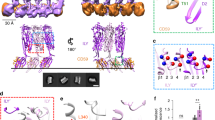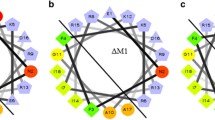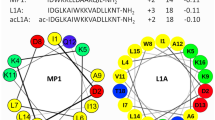Abstract
The release of granulysin, a 9-kDa cationic protein, from lysosomal granules of cytotoxic T lymphocytes and natural killer cells plays an important role in host defense against microbial pathogens. Granulysin is endocytosed by the infected target cell via lipid rafts and kills subsequently intracellular bacteria. The mechanism by which granulysin binds to eukaryotic and prokaryotic cells but lyses only the latter is not well understood. We have studied the effect of granulysin on large unilamellar vesicles (LUVs) and supported bilayers with prokaryotic and eukaryotic lipid mixtures or model membranes with various lipid compositions and charges. Binding of granulysin to bilayers with negative charges, as typically found in bacteria and lipid rafts of eukaryotic cells, was shown by immunoblotting. Fluorescence release assays using LUV revealed an increase in permeability of prokaryotic, negatively charged and lipid raft-like bilayers devoid of cholesterol. Changes in permeability of these bilayers could be correlated to defects of various sizes penetrating supported bilayers as shown by atomic force microscopy. Based on these results, we conclude that granulysin causes defects in negatively charged cholesterol-free membranes, a membrane composition typically found in bacteria. In contrast, granulysin is able to bind to lipid rafts in eukaryotic cell membranes, where it is taken up by the endocytotic pathway, leaving the cell intact.






Similar content being viewed by others
References
Anderson D.H., Sawaya M.R., Cascio D., Ernst W., Modlin R., Krensky A., Eisenberg D. 2003. Granulysin crystal structure and a structure-derived lytic mechanism. J. Mol. Biol. 325:355–365
Andersson M., Gunne H., Agerberth B., et al. 1995. NK-lysin, a novel effector peptide of cytotoxic T and NK cells. Structure and cDNA cloning of the porcine form, induction by interleukin 2, antibacterial and antitumour activity. EMBO J. 14:1615–1625
Arispe N., Doh M. 2002. Plasma membrane cholesterol controls the cytotoxicity of Alzheimer’s disease AßP (1–40) and (1–42) peptides. FASEB J. 16:1526–1536
Armstrong J.A., Hart P.D. 1971. Response of cultured macrophages to Mycobacterium tuberculosis, with observations on fusion of lysosomes with phagosomes. J. Exp. Med. 134:713–740
Bacia K., Scherfeld D., Kahya N., Schwille P. 2004. Fluorescence correlation spectroscopy relates rafts in model and native membranes. Biophys. J. 87:1034–1043
Brown D.A., London E. 2000. Structure and function of sphingolipid- and cholesterol-rich membrane rafts. J. Biol. Chem. 275:17221–17224
Brown R. 1998. Sphingolipid organization in biomembranes: What physical studies of model membranes reveal. J. Cell Sci. 111:1–9
Bruhn H., Leippe M. 1999. Comparative modeling of amoebapores and granulysin based on the NK-lysin structure-structural and functional implications. Biol. Chem. 380:1001–1007
Cambi A., de Lange F., van Maarseveen N.M., Nijhuis M., Joosten B., van Dijk E.M., de Bakker B.I., Fransen J.A., Bovee-Geurts P.H., van Leeuwen F.N., Van Hulst N.F., Figdor C.G. 2004. Microdomains of the C-type lectin DC-SIGN are portals for virus entry into dendritic cells. J. Cell. Biol. 164:145–155
Chamberlain A.K., Bowie J.U. 2004. Asymmetric amino acid compositions of transmembrane ß-strands. Protein Sci. 13:2270–2274
Clayberger C., Krensky A.M. 2003. Granulysin. Curr. Opin. Immunol. 15:560–565
Flynn J., Chan J., Triebold K., Dalton D., Stewart T., Bloom B. 1993. An essential role for interferon gamma in resistance to Mycobacterium tuberculosis infection. J. Exp. Med. 178:2249–2254
Gaillard J.L., Berche P., Mounier J., Richard S., Sansonetti P. 1987. In vitro model of penetration and intracellular growth of Listeria monocytogenes in the human enterocyte-like cell line Caco-2. Infect. Immun. 55:2822–2829
Geisow M.J., Evans W.H. 1984. pH in the endosome. Measurements during pinocytosis and receptor-mediated endocytosis. Exp. Cell Res. 150:36–46
Gidalevitz D., Ishitsuka Y., Muresan A.S., Konovalov O., Waring A.J., Lehrer R.I., Lee K.Y.C. 2003. Interaction of antimicrobial peptide protegrin with biomembranes. Proc. Natl. Acad. Sci. U.S.A. 100:6302–6307
Giocondi M.C., Milhiet P.E., Dosset P., Le Grimellec C. 2004. Use of cyclodextrin for AFM monitoring of model raft formation. Biophys. J. 86:861–869
Hanson D.A., Kaspar A.A., Poulain F.R., Krensky A.M. 1999. Biosynthesis of granulysin, a novel cytolytic molecule. Mol. Immunol. 36:413–422
Huijbregts R.P., de Kroon A.I., de Kruijff B. 2000. Topology and transport of membrane lipids in bacteria. Biochim. Biophys. Acta. 1469:43–61
Jass J., Tjarnhage T., Puu G. 2000. From liposomes to supported, planar bilayer structures on hydrophilic and hydrophobic surfaces: An atomic force microscopy study. Biophys. J. 79:3153–3163
Kaspar A.A., Okada S., Kumar J., Poulain F.R., Drouvalakis K.A., Kelekar A., Hanson D.A., Kluck R.M., Hitoshi Y., Johnson D.E., Froelich C.J., Thompson C.B., Newmeyer D.D., Anel A., Clayberger C., Krensky A.M. 2001. A distinct pathway of cell-mediated apoptosis initiated by granulysin. J. Immunol. 167:350–356
Kaufmann S.H.E. 1999. Cell-mediated immunity: Dealing a direct blow to pathogens. Curr. Biol. 9:R97-R99
Krensky A.M. 2000. Granulysin: A novel antimicrobial peptide of cytolytic T lymphocytes and natural killer cells. Biochem. Pharmacol. 59:317–320
Kurz A., Viertel D., Herrmann A., Muller K. 2005. Localization of phosphatidylserine in boar sperm cell membranes during capacitation and acrosome reaction. Reproduction 130:615–626
Liepinsh E., Andersson M., Ruysschaert J.M., Otting G. 1997. Saposin fold revealed by the NMR structure of NK-lysin. Nat. Struct. Biol. 4:793–795
Lynch E.C., Rosenberg I.M., Gitler C. 1982. An ion-channel forming protein produced by Entamoeba histolytica. EMBO J. 1:801–804
Manes S., del Real G., Martinez A.C. 2003. Pathogens: Raft hijackers. Nat. Rev. Immunol. 3:557–568
McMullen T.P., McElhaney R.N. 1997. Differential scanning calorimetric studies of the interaction of cholesterol with distearoyl and dielaidoyl molecular species of phosphatidylcholine, phosphatidylethanolamine, and phosphatidylserine. Biochemistry 36:4979–4986
Mombelli E., Morris R., Taylor W., Fraternali F. 2003. Hydrogen-bonding propensities of sphingomyelin in solution and in a bilayer assembly: A molecular dynamics study. Biophys. J. 84:1507–1517
Morimoto S., Martin B.M., Kishimoto Y., O’Brien J.S. 1988. Saposin D: A sphingomyelinase activator. Biochem. Biophys. Res. Commun. 156:403–410
Morimoto S., Martin B.M., Yamamoto Y., Kretz K.A., O’Brien J.S., Kishimoto Y. 1989. Saposin A: Second cerebrosidase activator protein. Proc. Natl. Acad. Sci. U.S.A. 86:3389–3393
Munford R., Sheppard P., O’Hara P. 1995. Saposin-like proteins (SAPLIP) carry out diverse functions on a common backbone structure. J. Lipid Res. 36:1653–1663
Niu S.L., Litman B.J. 2002. Determination of membrane cholesterol partition coefficient using a lipid vesicle-cyclodextrin binary system: Effect of phospholipid acyl chain unsaturation and headgroup composition. Biophys. J. 83:3408–3415
O’Brien J., Kishimoto Y. 1991. Saposin proteins: Structure, function, and role in human lysosomal storage disorders. FASEB J. 5:301–308
Ohtake S., Schebor C., de Pablo J.J. 2006. Effects of trehalose on the phase behavior of DPPC-cholesterol unilamellar vesicles. Biochim. Biophys. Acta. 1758:65–73
Pena S.V., Krensky A.M. 1997. Granulysin, a new human cytolytic granule-associated protein with possible involvement in cell-mediated cytotoxicity. Semin. Immunol. 9:117–125
Pomorski T., Holthuis J.C.M., Herrmann A., van Meer G. 2004. Tracking down lipid flippases and their biological functions. J. Cell Sci. 117:805–813
Pouny Y., Rapaport D., Mor A., Nicolas P., Shai Y. 1992. Interaction of antimicrobial dermaseptin and its fluorescently labeled analogues with phospholipid membranes. Biochemistry 31:12416–12423
Pralle A., Keller P., Florin E.-L., Simons K., Horber J.K.H. 2000. Sphingolipid-cholesterol rafts diffuse as small entities in the plasma membrane of mammalian cells. J. Cell Biol. 148:997–1007
Qi X., Grabowski G.A. 2001. Differential membrane interactions of saposins A and C. Implications for the functional specificity. J. Biol. Chem. 276:27010–27017
Ramamoorthy A., Thennarasu S., Tan A., Lee D.K., Clayberger C., Krensky A.M. 2006. Cell selectivity correlates with membrane-specific interactions: A case study on the antimicrobial peptide G15 derived from granulysin. Biochim. Biophys. Acta. 1758:154–163
Renswoude J.V., Bridges K.R., Harford J.B., Klausner R.D. 1982. Receptor-mediated endocytosis of transferrin and the uptake of Fe in K562 cells: Identification of a nonlysosomal acidic compartment. Proc. Natl. Acad. Sci. U.S.A. 79:6186–6190
Shai Y. 1999. Mechanism of the binding, insertion and destabilization of phospholipid bilayer membranes by alpha-helical antimicrobial and cell non-selective membrane-lytic peptides. Biochim. Biophys. Acta. 1462:55–70
Simons K., Ikonen E. 1997. Functional rafts in cell membranes. Nature 387:569–572
Simons K., Vaz W.L. 2004. Model systems, lipid rafts, and cell membranes. Annu. Rev. Biophys. Biomol. Struct. 33:269–295
Slotte J.P. 1999. Sphingomyelin-cholesterol interactions in biological and model membranes. Chem. Phys. Lipids 102:13–27
Smyth M.J., Kelly J.M., Sutton V.R., Davis J.E., Browne K.A., Sayers T.J., Trapani J.A. 2001. Unlocking the secrets of cytotoxic granule proteins. J. Leukocyte Biol. 70:18–29
Stegelmann F., Bastian M., Swoboda K., Bhat R., Kiessler V., Krensky A.M., Roellinghoff M., Modlin R.L., Stenger S. 2005. Coordinate expression of CC chemokine ligand 5, granulysin, and perforin in CD8 + T cells provides a host defense mechanism against Mycobacterium tuberculosis. J. Immunol. 175:7474–7483
Stenger S., Hanson D.A., Teitelbaum R., Dewan P., Niazi K.R., Froelich C.J., Ganz T., Thoma-Uszynski S., Melian A., Bogdan C., Porcelli S.A., Bloom B.R., Krensky A.M., Modlin R.L. 1998. An antimicrobial activity of cytolytic T cells mediated by granulysin. Science 282:121–125
Tannert A., Pohl A., Pomorski T., Herrmann A. 2003. Protein-mediated transbilayer movement of lipids in eukaryotes and prokaryotes: The relevance of ABC transporters. Int. J. Antimicrob. Agents 22:177–187
Tong J., McIntosh T.J. 2004. Structure of supported bilayers composed of lipopolysaccharides and bacterial phospholipids: Raft formation and implications for bacterial resistance. Biophys. J. 86:3759–3771
Vaccaro A.M., Ciaffoni F., Tatti M., Salvioli R., Barca A., Tognozzi D., Scerch C. 1995. pH-dependent conformational properties of saposins and their interactions with phospholipid membranes. J. Biol. Chem. 270:30576–30580
Vaccaro A.M., Salvioli R., Tatti M., Ciaffoni F. 1999. Saposins and their interaction with lipids. Neurochem. Res. 24:307–314
Walch M., Eppler E., Dumrese C., Barman H., Groscurth P., Ziegler U. 2005. Uptake of granulysin via lipid rafts leads to lysis of intracellular Listeria innocua. J. Immunol. 174:4220–4227
Young J.D., Young T.M., Lu L.P., Unkeless J.C., Cohn Z.A. 1982. Characterization of a membrane pore-forming protein from Entamoeba histolytica. J. Exp. Med. 156:1677–1690
Acknowledgement
We are grateful to A. Vogetseder and M. Le Hir for critical discussion of the manuscript, G. Barmettler for excellent technical help and M. Scott of the Functional Genomics Center at the University of Zurich for help during experiments using a Biacore (Uppsala, Sweden). We thank the Rudolf and Fridl Buck Foundation for financial support.
Author information
Authors and Affiliations
Corresponding author
Rights and permissions
About this article
Cite this article
Barman, H., Walch, M., Latinovic-Golic, S. et al. Cholesterol in Negatively Charged Lipid Bilayers Modulates the Effect of the Antimicrobial Protein Granulysin. J Membrane Biol 212, 29–39 (2006). https://doi.org/10.1007/s00232-006-0040-3
Received:
Revised:
Published:
Issue Date:
DOI: https://doi.org/10.1007/s00232-006-0040-3




